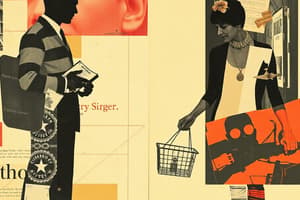Podcast
Questions and Answers
What is consumer behavior?
What is consumer behavior?
- The marketing strategies of companies.
- The analysis of market trends.
- The processes a consumer uses to make purchase decisions. (correct)
- The preferences of producers.
What is the consumer decision-making process?
What is the consumer decision-making process?
A five-step process used by consumers when buying goods and services.
What triggers need recognition?
What triggers need recognition?
An imbalance between actual and desired states.
Define 'want' in the context of consumer behavior.
Define 'want' in the context of consumer behavior.
What is a stimulus?
What is a stimulus?
What is an internal information search?
What is an internal information search?
What does an external information search involve?
What does an external information search involve?
Define nonmarketing-controlled information source.
Define nonmarketing-controlled information source.
What is a marketing-controlled information source?
What is a marketing-controlled information source?
What is an evoked set?
What is an evoked set?
What are brand extensions?
What are brand extensions?
What is cognitive dissonance?
What is cognitive dissonance?
Define involvement in consumer behavior.
Define involvement in consumer behavior.
What characterizes routine response behavior?
What characterizes routine response behavior?
Describe limited decision making.
Describe limited decision making.
What is extensive decision making?
What is extensive decision making?
Define culture in consumer behavior.
Define culture in consumer behavior.
What is a value?
What is a value?
Define subculture.
Define subculture.
What is social class?
What is social class?
What is a reference group?
What is a reference group?
Define primary membership group.
Define primary membership group.
What is a secondary membership group?
What is a secondary membership group?
What is an aspirational reference group?
What is an aspirational reference group?
Define norm.
Define norm.
What is a non-aspirational reference group?
What is a non-aspirational reference group?
What is an opinion leader?
What is an opinion leader?
What is a sponsored blog?
What is a sponsored blog?
Define shilling.
Define shilling.
What is the socialization process?
What is the socialization process?
What is personality in the context of consumer behavior?
What is personality in the context of consumer behavior?
Define self-concept.
Define self-concept.
What is the ideal self-image?
What is the ideal self-image?
Define real self-image.
Define real self-image.
What is self-monitoring?
What is self-monitoring?
What is lifestyle?
What is lifestyle?
What is perception?
What is perception?
Define selective exposure.
Define selective exposure.
What is selective retention?
What is selective retention?
Define motive.
Define motive.
What is Maslow's hierarchy of needs?
What is Maslow's hierarchy of needs?
What is learning in the context of consumer behavior?
What is learning in the context of consumer behavior?
Define stimulus generalization.
Define stimulus generalization.
What is stimulus discrimination?
What is stimulus discrimination?
What is a belief?
What is a belief?
Define attitude.
Define attitude.
Flashcards are hidden until you start studying
Study Notes
Consumer Behavior Fundamentals
- Consumer behavior involves the processes used to make purchase decisions, as well as using and disposing of products.
- Factors influencing consumer decisions include personal, social, and cultural elements.
Consumer Decision-Making Process
- A five-step process guides consumers through purchasing goods and services, from need recognition to post-purchase evaluation.
Key Concepts in Decision Making
- Need recognition arises from a gap between actual and desired states.
- A want represents the method a consumer employs to satisfy a recognized need.
- Stimuli, including sensory inputs, play a crucial role in influencing consumer behavior.
Information Search Techniques
- An internal information search draws on past experiences.
- An external information search involves seeking information from outside sources.
Information Source Categories
- Nonmarketing-controlled sources provide unbiased product information, while marketing-controlled sources promote products through advertising.
Brand and Product Evaluation
- The evoked set consists of brands a consumer considers after an information search.
- Brand extensions leverage the reputation of a well-known brand into new product categories.
Post-Purchase Feelings
- Cognitive dissonance refers to the stress consumers feel when their beliefs and behaviors are inconsistent.
Level of Consumer Involvement
- Routine response behavior involves minimal effort in purchasing low-cost items.
- Limited decision making is required for familiar products that are less frequently purchased.
- Extensive decision making is essential for high-involvement purchases of unfamiliar, expensive items.
Cultural and Social Influences
- Culture consists of shared values, norms, and symbols that shape behavior through generations.
- Subcultures reflect unique aspects within a larger culture, while social classes group individuals based on socioeconomic status.
- Reference groups, including primary and secondary membership groups, influence purchasing behavior through social interactions.
Personal Identity and Consumer Attitudes
- Self-concept captures how individuals perceive themselves, influencing their purchasing decisions.
- The ideal self-image is the desired perception, whereas a real self-image reflects current self-views.
Psychological Factors in Consumer Behavior
- Personality and lifestyle are important identifiers of consumer behavior.
- Perception involves organizing and interpreting sensory information, leading to selective exposure and retention of relevant data.
Motivations and Needs
- Motivations drive actions to fulfill specific needs, classified by Maslow's hierarchy into five ascending categories: psychological, safety, social, esteem, and self-actualization.
Learning and Attitude Formation
- Learning, shaped by experience, leads to behavioral changes.
- Attitudes represent consistent behavioral tendencies towards objects, influenced by beliefs, which are individual truths about the world.
Stimulus Responses
- Stimulus generalization extends learned responses to similar stimuli.
- Stimulus discrimination helps consumers differentiate between similar products.
Studying That Suits You
Use AI to generate personalized quizzes and flashcards to suit your learning preferences.




